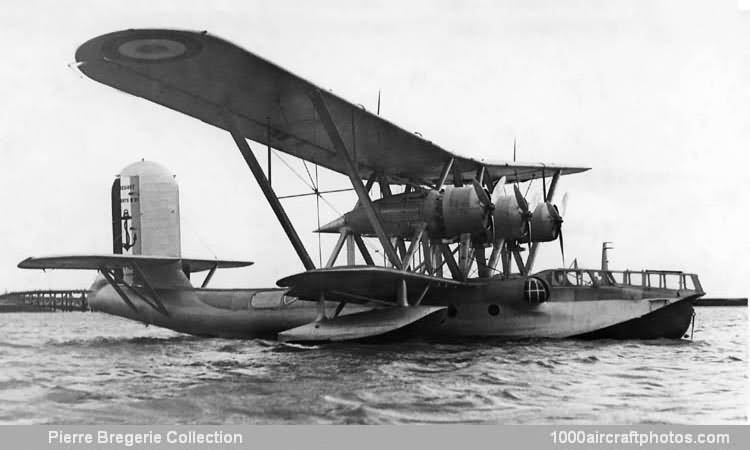The prototype, the Br 521-01, was built to meet the requirements of a French Navy specification for a long-range sea reconnaissance flying boat issued in 1932, and powered by three 825 hp Gnome & Rhône 14 Kdrs fourteen-cylinder air-cooled radial engines, the aircraft flew for the first time at Le Havre on September 11, 1933. During initial trials, the uncowled engines were fitted with NACA cowlings, and in January 1934 official trials began at Saint Raphael.
These trials continued until mid-September 1934, and on April 1, 1935, the prototype was flown to Cherbourg for operational evaluation with Escadrille 1E2. An initial pre-production batch of three Bizerte flying boats had been ordered in the previous year, and the first of these completed its preliminary trials at Le Havre in October 1935, but the second production machine embodied several modifications, the principal of which were the elimination of the open bow gun position, the extension of the cockpit canopy, and the introduction of blister-type gun positions in the fuselage sides immediately aft of the flight deck.
The Bizerte was of all-metal construction, and all fuel was housed in the lower wing, the tanks having a total capacity of 1,387 gal (5250 l). Armament comprised a single 0.295 in (7.5 mm) Darne machine gun in each side of the forward hull, two similar machine guns aft of the wings, and a fifth in a tail position, while four 165 lb (75 kg) Type G2 bombs could be carried on underwing racks. The production Bizerte was powered by 900 hp Gnome & Rhône 14 Kirs 1 radials, and Escadrilles E2 and E3 began converting to the flying boat before the end of 1935. Several small production orders were placed, the seventh Bizerte being delivered in March 1936, and the twelfth before the end of the year.
The twelfth machine was, in fact, powered by three Hispano-Suiza 14AA radials and received the designation Br 522, but was the sole machine of this type to be completed, all other Bizertes having the Gnome & Rhône radials. A further batch of nine machines was ordered on November 30, 1936, followed by an additional three machines on October 18, 1937, these small orders being sufficient to ensure continuity of production. On April 10, 1937, the Le Havre plant had been taken over by the SNCA du Nord, but this had no effect on Bizerte production, the 25th to 28th machines being delivered in September 1938.
On September 1, 1939, Escadrilles E1, E2, E3 and E5, each had either four or five Bizertes on strength, and on October 15, 1939, a further Escadrille, E9, was formed at Berre with four Bizertes. Despite the obsolescence of the design, an order for a further twelve Bizerte flying boats had been placed on September 12, 1939, these differing from earlier machines in having Gnome & Rhône 14N-11 radials (still of 900 hp) driving Gnome & Rhône airscrews, and modified R/T equipment. In the event, on December 12, this order was reduced to three machines, the first of which flew in February 1940.
From the beginning of hostilities, the Bizerte patrolled the Atlantic and the Mediterranean. On August 1, 1940, Escadrilles E1, E2, E3, E5, and E9 were respectively redesignated 1E, 2E, 3E, 5E and 9E, and on the 15th of that month, twenty Bizerte flying boats were still in service with the French Navy. Of these, ten were undergoing overhaul or repair, and one was awaiting scrapping. Of the five Bizerte-equipped Escadrilles, only two remained to serve with the Vichy Navy, 1E and 9E, the others being disbanded after the Armistice.
Escadrille 1E was sent to Karouba where it operated three Bizertes and three Lioré et Olivier LeO 257bis floatplanes, and 9E operated three Bizertes and three LeO H-470 flying boats from Berre. On November 8, 1942, the latter unit had four Bizertes, and these were promptly sequestered by the German forces and, together with four additional Bizertes found in storage, issued to the Luftwaffe after the occupation of Vichy France. These were flown on air-sea rescue sorties from Lorient and Saint Mandrier.
One of the Luftwaffe Bizertes was discovered by French forces on the Mediterranean coast in August 1944, and was used for communications duties with Flottille 9FTr until withdrawn owing to lack of spares."
Span: 115 ft 3.875 in (35.15 m)
Length: 67 ft 2.25 in (20.48 m)
Height: 24 ft 6.5 in (7.48 m)
Wing area: 1,750.21 sq.ft (162.6 sq.m)
Weight empty: 20,878 lb (9,470 kg)
Loaded weight: 33,271 lb (15,091 kg)
Max weight: 36,597 lb (16,600 kg)
Max speed: 151 mph (243 kmh) at 3,280 ft (1,000 m)
Cruise speed: 124 mph (200 kmh)
Climb: to 6,562 ft (2,000 m) 8 min 46 sec
Service ceiling: 19,685 ft (6,000 m)
Max range: 1,864 mls (3,000 km)
